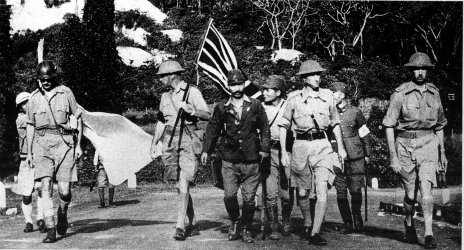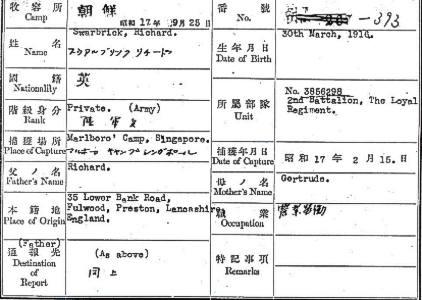|
Singapore Falls
|

|
|
The fall of Singapore
|
|
When Singapore fell to the Japanese at 6.10 p.m. on Sunday the 15th February 1942, Dick officially became a prisoner of war; although, as we have seen, some elements of the Loyals were still fighting at that time. 22 According to his record card he was officially taken prisoner at Marlborough Camp. This camp was some 400 yards east of the Ordnance Depot and it was where the remnants of B and the merged CD Companies had been ordered to hold as a reserve. These survivors, effectively a single company, were organised into two platoons. Just before 10 p.m. Dick and the rest of the men at Marlborough Camp received the news of the surrender in a message from Lieutenant-Colonel Elrington: I congratulate you on fighting so well. Through no fault of yours you have been ordered to surrender. Remember the lads who have fought and died, and show the same spirit of duty and discipline in defeat. Do nothing to bring discredit on the Loyals as prisoners of war. God bless you.
Following the order to surrender the troops used up what stores were left; the camp had been an R.O.A.C. establishment and so was relatively well supplied with food, clothing and medical supplies. Dick clearly remembers feasting on tinned peaches and cream. The Battalion Medical Officer stocked up on medical supplies and Holohan, the Battalion Quartermaster, secured supplies of anything and everything that might be needed during the coming months. The day after the surrender the Loyals marched the twenty or so miles to Changi Jail. Dick remembers that he had on him a large number of cigarettes, so many in fact he was giving them away to anyone who would take them; one month later, in the camp at Changi, cigarettes were worth their weight in gold; if only he had known!
At first the Battalion were held at Changi Jail, where the conditions enforced by the presence of so many prisoners were, to say the least, primitive. There were approximately 18,800 officers and men detained at Changi, far more than the jail had ever been designed to hold. In fact the Japanese used not only the jail itself, but also the surrounding areas. The Loyals were actually held in the Malay Lines, this was the area that had previously been the quarters of the Malay Sappers. Water came in by cart, it was rationed to half a gallon per man per day; and the latrines, no more than holes in the ground, were very near to the barracks which housed the men.
|

|
|
Dick’s POW record card PRO ref. WO 345 150
|
|
Too near as it turned out. Flies and disease inevitably followed. Dick, like so many others, contracted dysentery followed by diarrhoea and then dengue fever. The general health of the men was not helped by the meagre rations that they were allocated. In the summer of 1942 the ration scale was as follows:
Rice 500 gms Tea 5 gms
Salt 10 gms Flour 50 gms
Meat 50 gms Vegetables 100 gms
Milk 15 gms Sugar 30 gms
Oil 10 gms 23
Slowly the men and their officers became accustomed to the new routines that were part of their captivity. Tokyo time was introduced and everyone had to get used to the new times for meals. In the first days of their stay at Changi the men were allowed to bathe in the sea, but after a month or so the Japanese authorities decided that this was no longer allowed and barbed wire fences were erected to restrict access to the beaches. The enlisted men were expected to work, either on the jobs set by their captors or cutting wood for fuel and drawing the water that was their ration. What spare time the men had was devoted to theatricals and the odd game of cricket.
In April of 1942 the Loyals were engaged in building a “Victory Road” to the site of what was to be a memorial commemorating the Japanese victories in Malaya. For the duration of this task the officers and men were moved from the Malay Lines and quartered on the Caldecott Estate. The Caldecott estate had been a modern housing development before the war, but was by this stage deserted and rather the worse from bombing. The Loyals were there for about two months, up at first light for breakfast, then parade, then a three mile march to the road site. The men then laboured for eight hours, under the orders of their own officers, then the march back to the estate, a meal and bed.
The Japanese supervision appears to have been very low key, a few soldiers and an N.C.O. About four weeks after they had begun there occurred what was later known as “Freedom Week.” There seems to have been some kind of mix up with the Japanese guards, and the men woke one day to find themselves unguarded. They strolled off to the nearest town, mostly inhabited by Chinese, where they ordered meals in the cafes, had haircuts, shopped and generally did what men on leave did. According to Elrington’s account the Chinese, to show their opposition to the Japanese, refused payment for the meals and the other services of which the men availed themselves. After about a week the Japanese guard party returned and life went back to what passed for normal. 24
A few months later, in July of 1942, Dick and the rest of the Loyals, together with the officers and men of the Yorkshire based 122nd Field regiment, Royal Artillery and a few Australian troops were told that they were leaving Changi, as they thought at the time, for Japan. 25 On the 20th July all the thousand or so men concerned were paraded on Artillery Square for medical inspections. This was a fairly rudimentary procedure, but it did include the indignity of each man, officers included, having to undergo a public rectal examination to test for diseases such as dysentery. This seems to have occasioned much embarrassment amongst the officers and not a little amusement for the other ranks. 26 The men were supposed to depart the following day, the 21st July, but this did not happen and they all returned to Changi. There was some talk that traces of disease had been found, but no one seemed to know exactly what the reasons for the postponement were. 27
On the 14th August the same party of men were again assembled and the same medical inspections were repeated. Two days later the men were put on trucks and taken to Keppel Harbour. Here they were ordered aboard the Elistor Maru, where they were required to strip and their clothes were taken to be fumigated. Whilst their clothes were being treated the men themselves were ordered into hot baths, laced with disinfectant and other chemicals; the men were then re-united with their clothes. When dressed, they were marched off that ship and formed up on the dock, then marched off to embark on another ship tied up in the harbour.
Appendix
22 It has been estimated that there were some 150 men born in Preston who were captured that day in Singapore. A History of Preston by David Hunt.
23 Report of Col E.B. Holmes M.C. commanding officer British and Australian troops, Changi WO 32 14551
24 Lt Colonel Elrington’s account of the captivity published in The Lancashire Lad June 1949
25 According to Elrington [op cit] the Japanese authorities were not too concerned about who went and it was the Officers of the Loyals who decided that it was probably a good idea to go. There were several reasons for this: keeping the men together, it couldn’t be worse than Changi and the climate had to be better. As it turned out it was probably a good choice to have made.
26 Australian War Memorial website publication Prisoners on Parade: Japan Party “B” by de Groen and Masterman-Smith – part of the conference reports and papers to mark the 60th anniversary of the events of 1942.
27 Lt Col Elrington recorded that two men of the Loyals died from dysentery shortly after this medical inspection.
Next Chapter
Fukai Maru
|